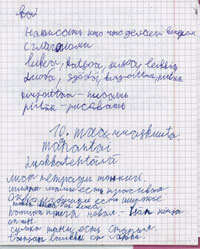Why Writing is Right for Children
 Handwriting of a modern school kid — don’t you think it’s time to change something?
Handwriting of a modern school kid — don’t you think it’s time to change something?
Technology could be harming your child’s ability to learn. Learning to write plays an important part in developing general life skills.
Why are fine motor skills so important? In the preschool years, being able to colour with crayons, cut with scissors, paint with a paintbrush, and play with small objects such as Lego, beads, and puzzles, are all integral to a child’s development. Self-care activities such as tying shoelaces and using a knife and fork to eat food, all require a degree of fine motor control. Children who struggle with any of these activities often feel frustrated and their self-esteem suffers when they can’t keep up with their peers. Writing by hand hones these skills and makes it easier for children to graduate to self-help activities, say experts.
«It’s true that a lot of fine motor skills have been lost due to lack of writing,» says Dr Onita Nakra, educational psychologist and counselor, American School of Dubai. «Children now have trouble opening their lunch boxes, buttoning their shirts, and opening bottle tops. Many even have to be taught how to push open doors.»
The benefits of gripping and moving a pen or pencil across paper go beyond mere communication. Indiana University research team studied the benefits of handwriting on children. They discovered that handwriting can change the way children learn and help their brains develop in entirely more productive ways.
Researchers who tested second, fourth, and sixth graders found that children compose essays more prolifically — and faster — when using a pen rather than a keyboard. Virginia Berninger, a University of Washington professor of educational psychology studies normal writing development and writing disabilities. Her research has shown that forming letters by hand may engage our thinking brains differently than pressing down on a key. Fourth and sixth graders wrote more complete sentences when they used a pen, she found.
«The contact, direction, and pressure of the pen or pencil send a message to the brain. The repetitive process of handwriting integrates motor pathways into the brain,» says Katya Feder, occupational therapist and a professor at the University of Ottawa School of Rehabilitation. «When it becomes automatic or learned, there’s almost a groove in the pathways. The more children write, the more pathways are laid down. But if they write them poorly, they will get a faulty pathway which has to be corrected.»
One reason why children are reluctant to write is because teachers focus more on the mechanics of writing, rather than on process. «Writing itself is a very complex activity,» says Dr Nakra. «There are developmental phases and stages for writing. With young children, teachers tend to focus more on the output, the product rather than the process.» This, Dr Nakra feels, is self-defeating. The focus should instead be on perfecting the process.
In Dr Nakra’s opinion, writing is not just a movement of the pen on paper using motor skills. It is also a way of firing imagination, mastering the means of expression through words and a whole new way of exploring one’s abilities. The teachers’ role, says Dr Nakra, is enormously important because they guide a child through so many creative processes in writing such as editing, proof reading, developing and shaping content as well.
Source: Friday magazine, Gulf News
For the largest part ill handwriting in the world is caused by hurry.
(Lewis Carroll)



